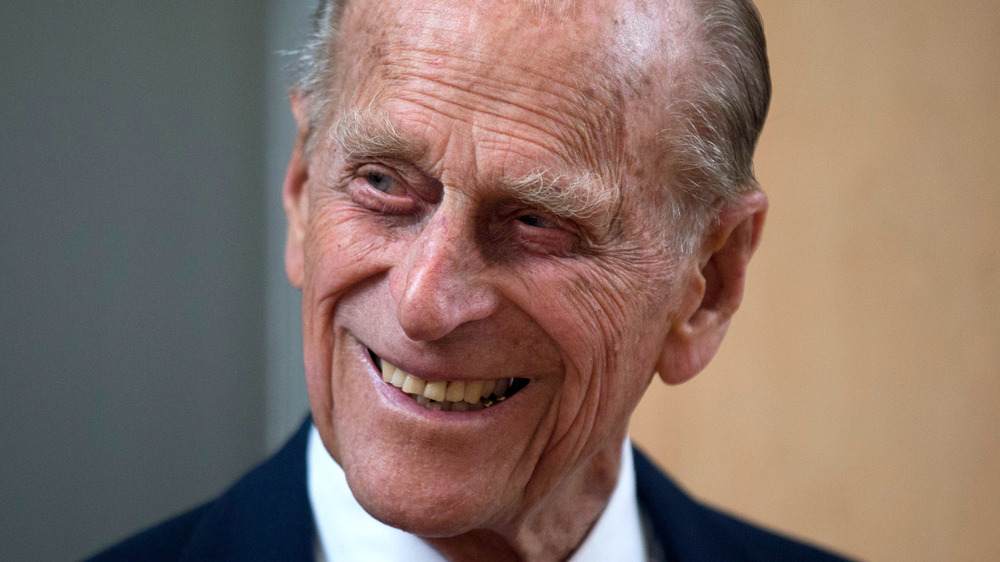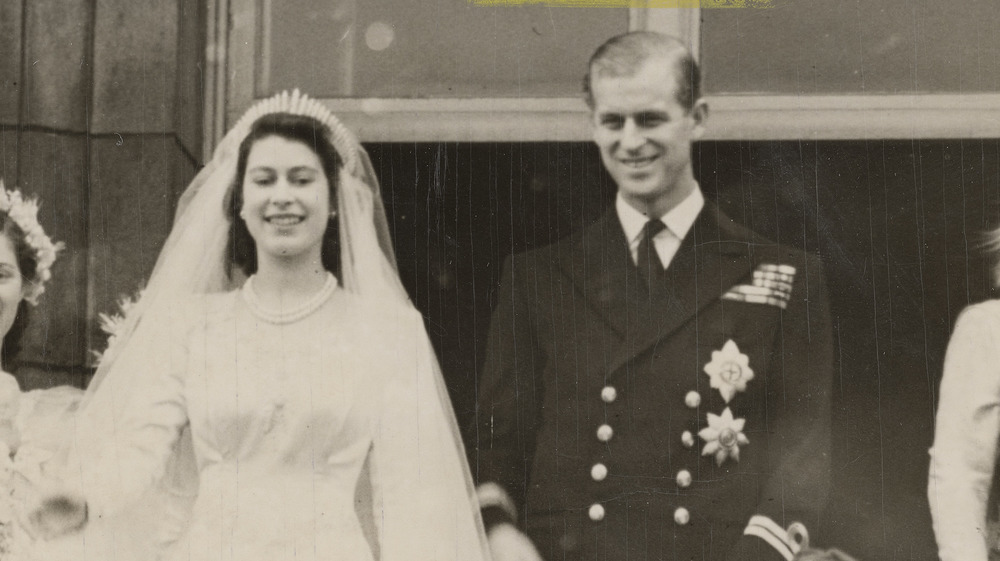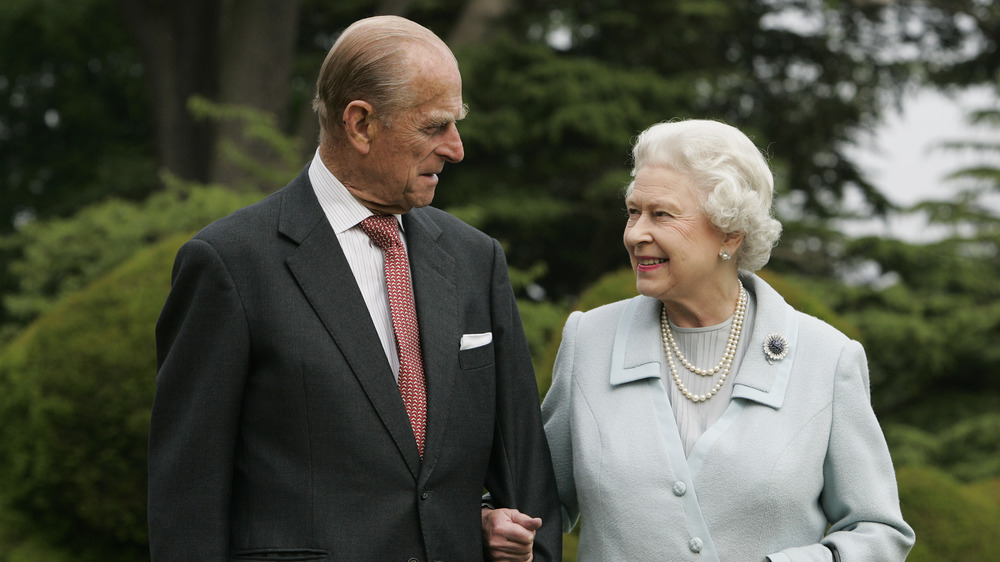The Untold Truth Of Prince Philip
We may receive a commission on purchases made from links.
Queen Elizabeth II has been England's monarch since her coronation in 1953, and standing by her side up until his death at age 99 on April 9, 2021 was her husband, Prince Philip. During those decades, the prince carved out his own unique role as consort to Her Majesty the Queen, helping her guide the monarchy through some tumultuous times.
Born in Greece as Prince Philip of Greece and Denmark, his family was exiled from the country of his birth while still an infant. His early years may have been difficult ones, but his fortunes changed when he fell in love with the future monarch, their impending nuptials necessitating that he become a naturalized British citizen. He also had to relinquish those royal titles, but received plenty more in their stead; in fact, Philip's full title is real mouthful, a full 133 words long.
Despite being one of the world's most recognizable people for well over a half-century, the Duke of Edinburgh (his most commonly used title) remained something of an enigma, a private man with a wry sense of humor that's landed him in hot water more than once. To find out more about this venerable royal, read on to discover the untold truth of Prince Philip.
Prince Philip had a turbulent childhood
Prince Philip was born in 1921 on the Greek island of Corfu, related to a who's who of European royalty; as Town & Country noted, his grandmother was descended from Russia's Romanovs while Christian IX of Denmark was his great grandfather.
Despite being born on an island paradise and being "sixth in line to the Greek throne," the young prince's childhood was anything but bucolic. When his grandfather, King George I, was assassinated, his uncle was crowned — but "forced to abdicate" after the Greco-Turkish war. Philip's father was accused of treason and fled to Paris, with the youngster passed from relative to relative, rarely seeing his parents.
His mother, Princess Alice, experienced a nervous breakdown in 1931 and was institutionalized; Philip, just 10 at the time, would not see or hear from her for the next several years. While his father developed a reputation as a degenerate gambler while in exile in the south of France, Philip's aunts and uncles arranged to send him to boarding school in Scotland. "When he needed a father, there just wasn't anybody there," Michael Parker, who served as the late prince's first private secretary, told The Independent.
Queen Elizabeth and Prince Philip fell in love when they were teenagers
Queen Elizabeth II was just eight years old the first time she met her future spouse, when they were both in attendance for the wedding of her uncle and his cousin, noted History Extra. It wasn't until their subsequent meeting, five years later, that royal sparks flew when the two met again while he, then 18, was attending the Royal Naval College.
They began writing to each other, launching a courtship that continued until 1946, when he asked her father, King George VI, "for his daughter's hand in marriage." The king agreed, but insisted "the formal announcement of the engagement" be "delayed" until the following year, when she turned 21.
There were some other conditions attached to the king's assent. Anti-German sentiment in Britain after the end of World War II was rampant; the fact that both Philip's sisters had wed Nazis coupled with his Germanic surname — Schleswig-Holstein-Sonderburg-Glücksburg — wouldn't exactly endear him to the British populace. Instead, Philip renounced his right to the thrones of Greek and Denmark and became a naturalized British citizen, taking on the surname of his mother, the far more British-sounding Mountbatten. Queen Elizabeth and Prince Philip were married in Westminster Abbey in 1947.
Prince Philip was related to Queen Elizabeth by more than just marriage
Prince Philip and Queen Elizabeth were not only spouses, they were also blood relatives. That's not particularly surprising given the history of the bloodlines of European royalty, however, with a marriage more likely to cement an alliance between nations than serve as a reflection of that crazy little thing called love.
In fact, a close look at the royal bloodlines of Europe demonstrates that any given royal is probably related to any other royal, and the queen and her late husband were no exception. To demonstrate the connection, Expedia created an interactive family tree tracing the connections of Nordic royalty, which extended to the British monarchy. As interpreted by The Independent, both Elizabeth and Philip hail from the House of Saxe-Coburg-Gotha (which was changed to the more British-sounding Windsor in 1917) and share a common ancestor: Queen Victoria, who is great-great-grandmother to both spouses.
In Elizabeth's case, her father, King George VI, was son of King George V, whose father was King Edward VII, Victoria's eldest son. Meanwhile, Philip's mother, Princess Alice of Battenberg, was born to Victoria's granddaughter, Princess Victoria of Battenberg, whose mother was Victoria's second daughter, Alice, Grand Duchess of Hesse — making them third cousins.
The incredible life of Prince Philip's mother
Anyone keeping up with Netflix's The Crown will recall the saga of the late Prince Philip's mother, Princess Alice of Battenberg. Placed in a psychiatric facility when her son was a child, the princess was diagnosed with schizophrenia (a diagnosis she disputed).
While her mental acuity may have been a matter of debate, her royal pedigree was not: great-granddaughter of Queen Victoria, she was born in Windsor Castle, and wed Prince Andrew of Greece and Denmark. When political instability in Greece led the royals into exile, recalled Esquire, she converted to the Greek Orthodox religion and became devoutly religious. Returning to Greece, she became a nun, living a modest life in Athens, devoting herself to feeding the hungry and working with the Red Cross, even hiding a Jewish widow and her children from the Gestapo.
In 1949, Princess Alice established the Christian Sisterhood of Martha and Mary in Athens; while attending the queen's coronation, she wore her simple nun's habit. When Greece became embroiled in turmoil in the late 1960s, the queen feared for her mother-in-law's safety, and brought her to live in Buckingham Palace. That was where she died in 1969, penniless after donating all her worldly possessions to the poor.
Prince Philip's wartime heroics weren't revealed until six decades after WWII
It's a testament to the late Prince Philip's humble nature that an act of wartime heroism didn't come to light until six decades after he served in the Royal Navy during the Second World War. Harry Hargreaves, who served alongside the 21-year-old prince aboard the HMS Wallace, related the tale to The Guardian.
Lieutenant Philip Mountbatten was "second-in-command" of the vessel when a Luftewaffe bomber flew overhead during the Allied invasion of Sicily. As Hargreaves recalled, it was the middle of the night, and while the bomber pilot hadn't been able to land a direct hit, they felt it was "inevitable" that the ship would be bombed and sunk.
The fast-thinking prince sprang into action. While the bomber was circling to make another attempt, he devised a plan to throw a wooden raft into the water, with smoke floats that would go off when hitting the water, sending thick plumes of smoke wafting in the air to mimic burning debris. The idea worked, creating a decoy target while the ship was able to scoot away to safety in the darkness. "Prince Philip saved our lives that night," declared Hargreaves.
Buckingham Palace staffers reportedly favored Prince Philip
In the first two seasons of Netflix's The Crown, Matt Smith portrayed Prince Philip. As he revealed in an interview with Variety, the former Doctor Who star undertook some heavy duty research about the iconic royal he portrayed onscreen.
In that research, Smith came to discover much of what he thought he knew about the Duke of Edinburgh simply wasn't accurate. One thing Smith discovered about Philip was his reputation for being "brilliantly funny, very clever, very popular. In the royal house he's the most popular of all of them. If you've talked to any of the staff, Philip's the one they all love really."
According to Smith, Philip was "a bit more of a man of the people" than other members of the royal family. "The royal protocol hasn't dogged him in quite the same way his whole life and there's a sort of rebellion in him and a naughtiness and a cheekiness," added the actor. "I think he's quite affable and open by all accounts with the staff. They all love him."
This tropical nation worships Prince Philip as a god
While it's no secret that Britain's royal family is revered worldwide, a tribe on a tiny island in the South Pacific have taken their admiration of Prince Philip to extremes. "For them Philip is a tabu man — human but possessing qualities and powers that make him sacred," Matthew Baylis, who wrote a book about his experience living with the tribe on Vanuatu's Tanna Island, told Australia's ABC.
According to Global News, the villagers believe Philip is the fulfillment of an ancient tribal legend in which the "pale-skinned son of the mountain god" journeys across the sea and returns with a rich and powerful wife. Kirk Huffman, honorary curator of the National Museum of Vanuatu, told ABC that Philip is aware of the villagers' beliefs, and even met with five Tannese men in Windsor Castle when they visited Britain in 2007.
"Here in Tanna, we believe that Prince Philip is the son of our god, our ancestral god, who lives up in the mountain," one of the villagers told Associated Press. "We ask him to increase the production of our crops in the garden, or to give us the sun, or rain. And it happens." ABC additionally reported that Prince Philip visited the island in 1974 and the tribe "believe[s] he will one day return ... probably in a spiritual form."
Prince Philip was the longest-serving consort in British history
When Queen Elizabeth II was coronated in 1953, who could have foreseen that she would still be on the throne nearly seven decades later, well into her 90s? Throughout those many years, Prince Philip was planted steadfastly by her side.
In fact, it was back in 2009 that the Duke of Edinburgh celebrated a big milestone when he officially became the longest-serving consort to a monarch in the history of Britain. At the time, reported The Scotsman, he beat the previous "record of 57 years and 70 days set by Queen Charlotte, the wife of King George III," who reigned from 1760 until 1820.
Philip could also boast of being the longest-serving husband to a British queen, surpassing the record that had previously been held by his own grandfather, Prince Albert, who was consort to Queen Victoria for 21 years before dying at 42.
He didn't think of himself as British
Members of European royalty over the centuries have tended to keep their marriages within the royal gene pool, which explains why Prince Philip and Queen Elizabeth II were both spouses and third cousins. In terms of his own heritage, Prince Philip may have appeared to have beeen quintessentially British, however, as he explained to The Independent, that isn't how he thought of himself.
"If anything, I've thought of myself as Scandinavian. Particularly, Danish," recalled Philip. "We spoke English at home. The others learned Greek. I could understand a certain amount of it. But then the [conversation] would go into French. Then it went into German, on occasion, because we had German cousins. If you couldn't think of a word in one language, you tended to go off in another."
When Prince Philip changed his surname from Schleswig-Holstein-Sonderburg-Glücksburg to Mountbatten, The Scotsman noted, he knew that his new name would not be passed on to his progeny; instead, his children use their mother's last name, Windsor. "I am the only man in the country who can't give his name to his children," he reportedly once said.
Prince Philip had a modest streak
While Prince Philip had become famed for his public gaffes, he also earned a quiet reputation for his understated humility. That trait was on display in a 2011 BBC One television special to mark his 90th birthday, reported BBC News, when he was asked whether he'd been "successful in his role" as the queen's consort. "I couldn't care less," he said, adding, "Who cares what I think about it, I mean it's ridiculous."
As the outlet pointed out, he'd also been lauded for launching the Duke of Edinburgh's Award, a charitable endeavor that helps guide young people develop the skills that will carry them toward a successful future. However, he also refused to take any credit for its success. "I don't run it — I've said it's all fairly secondhand the whole business. I mean, I eventually got landed with the responsibility or the credit for it," he said, adding, "I've got no reason to be proud of it. It's satisfying that we've set up a formula that works — that's it."
It's the simple things in life that Prince Philip enjoyed
In 2017, Buckingham Palace announced that Prince Philip, at the age of 96, was retiring. As BBC News reported, an attendee at a royal event told him, "I'm sorry to hear you're standing down." Quipped the prince, "Well, I can't stand up much."
According to Daily Beast, Philip followed up his retirement announcement by moving out of Buckingham Palace, splitting his time between Windsor Castle and Wood Farm, a modest cottage — formerly the manager's residence — on the grounds of the queen's estate in Sandringham. The move, reported the outlet, is part of a "long held joint fantasy of Philip and the Queen; the dream of quietly living out their days as 'normal' people in the Shires."
In fact, the prince's post-retirement days were reportedly spent painting, reading, and writing letters. Philip and Queen Elizabeth, who are worth an estimated $600 million, were said to enjoy "role playing a distinctly middle-class vision of domesticity" at Wood Farm, which includes the queen putting on a pair of rubber gloves to clean up the dishes after one of her husband's "legendary barbecues."
Here's the one delicacy Prince Philip refused to embrace
According to former royal chef Darren McGrady, "Prince Philip has a much broader palate than Her Majesty when it comes to food." As McGrady once said, via Hello!, "The Queen eats to live whereas Prince Philip lives to eat." Philip also enjoyed cooking; McGrady recalled one time at Sandringham when he was in the process of preparing lamb when the prince took over and grilled the meat himself. "He actually cooked on the grill that night — he cooked for me!" marveled McGrady.
While the Duke of Edinburgh was said to have a sophisticated palate — salmon coulibiac was reportedly a favorite dish — there's one particular delicacy that neither he nor the queen embraced: raw oysters. As Hello! reported, anyone hosting a dinner at which the queen and Philip will be attending receive the following instruction: "Neither the Queen nor the Duke of Edinburgh like oysters."
According to former royal butler Grant Harold, via Woman & Home, avoiding raw shellfish is "a very sensible move" for the royal couple. "We don't want a member of the royal family having a serious reaction to food poisoning," particularly while on "an overseas tour."
Prince Philip helped to redefine an equestrian sport
Since his retirement in 2017, Prince Philip used his free time to indulge in an activity describe by Daily Beast as "one of the great passions of his life" — carriage driving.
Not only has carriage driving been a lifelong hobby for Philip, he is a world-renowned expert and competitor in the equestrian sport. In fact, he wrote an entire book about the subject, Competition Carriage Driving, published in 1994. According to the book's blurb, it shares his "advice and encouragement on all aspects of training, vehicles, harness, preparation, driving, and competing."
In addition, Philip also served as president of Fédération Equestre Internationale (FEI) for 22 years. On the occasion of his 99th birthday, the FEI offered a tribute to the "world-class driving athlete" who won the world championship for Great Britain in 1980. "Not only was Prince Philip a good athlete in a lot of disciplines, he was also a real leader and managed to turn the equestrian sports into something more professional," said equestrian historian Marie de Pellegars, author of An Illustrated History of Equestian Sports.
He was a talented painter
When not racing carriages, another activity Prince Philip enjoyed over the years is oil painting. To commemorate his 90th birthday, a special exhibition was held in celebration of his life. Among the many aspects of his life covered in the exhibit was one section devoted to his painting and other design work.
"Prince Philip is interested in art and design, both as a patron and collector, and as an artist himself," reads the description of one of his painting of Duart Castle from the Sound of Mull in the Western Isle, which also notes that "he paints mostly landscapes in oils." Other work featured in the exhibition was a jewel-encrusted bracelet that he designed as a gift for the Queen in celebration of their fifth anniversary, and his own hand-drawn design for a stained-glass window for the chapel of Windsor Castle, which was badly damaged in a 1992 fire.
In 2010, the Daily Mail published another of his paintings, a portrait of the Queen having breakfast. "I think generally people don't known [sic] that the Duke of Edinburgh paints, it's quite a private pursuit," Jennifer Scott, assistant curator of paintings at the Royal Collection, told the Mail, describing it as "a really good painting."















